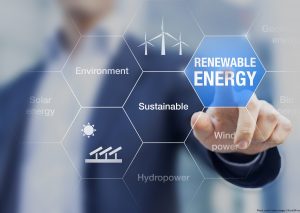 Using renewable energy is a hot topic in the waste management industry, but it’s one that many people know less about than they think. Sure, we all recognize the most common renewable energy sources, like solar power and wind energy. But, there are many other types of renewable energy that aren’t quite as common knowledge. Did you know that sewage waste is now being used to heat and cool buildings? Or, that wasted food is used to generate electricity? Our waste has increasingly become a valuable way to replace non-renewable energy sources. Here are a few surprising examples:
Using renewable energy is a hot topic in the waste management industry, but it’s one that many people know less about than they think. Sure, we all recognize the most common renewable energy sources, like solar power and wind energy. But, there are many other types of renewable energy that aren’t quite as common knowledge. Did you know that sewage waste is now being used to heat and cool buildings? Or, that wasted food is used to generate electricity? Our waste has increasingly become a valuable way to replace non-renewable energy sources. Here are a few surprising examples:
1. Biomass
Biomass, organic materials like scrap lumber, forest debris, crops, and manure, can be used as fuel to create electricity or other forms of power. This type of waste, which generally comes from demolition, construction, or farming practices, can be burned to create heat. In biomass power plants, this heat is harnessed and used to heat industries and homes, or it is used to produce steam. The steam from burning biomass fuel is used to run turbines to make electricity.
2. Sewage
There is a near constant stream of warm sewage that comes from the biomatter, dishwashers, showers, and industrial processes that produce hot water and send it down the drain. Researchers in China have found ways to capture this heat and use it to regulate temperature inside buildings. In Philadelphia, this technology has been installed at the Southeast Wastewater Treatment Plant. Using only sewage and wastewater, a 20,000 square foot compressor building at the plant is fully heated and cooled by the system.
3. Landfill Gas
The life cycle of your garbage doesn’t end when it’s dumped at the landfill. Instead, once there, the decomposition of solid waste begins to produce a byproduct that can be used in surprising ways. Methane gas, a by-product of garbage decomposition, is collected at landfills and used as thermal energy, to generate electricity, or to do both at the same time. Landfill gas is also being used as an alternative to fossil fuels like natural gas.
4. Waste Heat
Major data centers, like IBM’s Zurich Research Laboratory, use water to cool down its servers. Once the water has done its job, these centers are left with hot water that is often treated as waste heat. Now, instead of disposing of this waste, it is being used to heat nearby homes. Much like hot sewage is used to warm buildings, other forms of waste heat, like that produced when cooling machinery, can be used to generate alternative heating and cooling systems.
5. Food Waste
Heartland Biogas Project in northern Colorado is just one example of an organization that is finding ways to use food waste to create energy. They, like many others, collect millions of gallons of food waste and combine it with anaerobic digesters. These digesters are bacteria that break down the waste. In the process, they give off methane. This methane is a powerful gas used to generate electricity and other forms of renewable energy.
How KenBay Can Help You Manage Your Waste
Whether or not your business produces waste that can be used as a renewable energy source, we know waste management can be a burden. Because trash compactors will reduce the weight and size of your waste, they are a great way to cut down your waste removal costs and improve the efficiency of waste management.
Trash compactors like KenBay’s RotoPac are ideal for industrial settings, and allow companies to reduce the volume of their trash at a ratio of six to one. The RotoPac can handle all kinds of waste from food to recyclables, and even solid hazardous waste.
Don’t let something like a waste get in the way of your business operations. If you’re interested in trash compactors or finding a committed consultant to help you reduce your waste, call KenBay. We can tell you more about our services, no matter what industry you’re in, or how much waste you are creating!
Photo credit: Getty Images / NicoElNino


